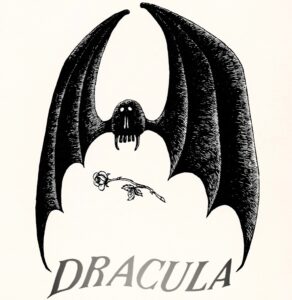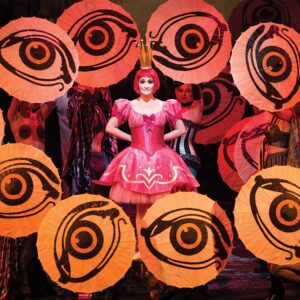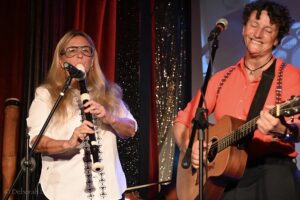A Very Gorey Dracula
Five decades ago, illustrator and writer Edward Gorey channeled his fascination with the macabre to the stage with set and costume designs for an adaptation of Bram Stoker’s Dracula. The production won Gorey a Tony Award, and its financial success contributed to his purchase of the home in Yarmouth Port that would eventually become the Edward Gorey House museum.

Eight miles from the museum, the Cape Cod Theatre Company is taking inspiration from Gorey’s signature style for its own Dracula adaptation this month after receiving rarely granted permission from the Edward Gorey Charitable Trust to use the late artist’s images in its production.

“Dracula feels so at home on Cape Cod,” says director Brian Lore Evans, who adds that the Cape’s spooky off-season vibe is ideal for Gorey’s playful views on dark topics.
While the century-old story of dapper Count Dracula (played by Wellfleet’s John O. Fennell) stalking young women to drink their blood could teeter into melodrama, Evans says he’s aiming for Gorey’s “macabre with a wink” style.
“I’m more interested in that feeling when you’re curled up with a blanket watching a scary movie with a cup of hot chocolate than I am in jump-scares,” he says.
Working with the theater’s producing artistic director Jenn Pina, Evans has added an ensemble of actors to the script that Pina says supplies much of the vampire “magic.” While Evans says he wants to keep most of the story changes and homages to Gorey a surprise for audiences, he does divulge that many of Gorey’s bat illustrations are incorporated into the set and costume designs for the show. A giant Gorey bat is also featured on its poster.
Dracula runs Oct. 3 to 27 at Cape Cod Theatre Company/Harwich Junior Theatre (105 Division St., West Harwich). Tickets are $18-$28 at capecodtheatrecompany.org. —Kathi Scrizzi Driscoll
The Song Remains the Same But Feels Different
In 2004, New York-based guitarist Steph Paynes found herself listening to a lot of Led Zeppelin. “I was itching to play challenging, dynamic, heavy music,” she says. So, Lez Zeppelin was born: an all-girl rock quartet covering the music of one of rock’s most influential (and loudest) bands. “I definitely thought it should be girls,” Paynes says. “That was obvious to me.”

After its Provincetown debut last year, Lez Zeppelin will return for a concert at Provincetown Town Hall on Saturday, Oct. 5 as part of the Payomet Road Show series. The band is currently composed of Paynes on guitar, Marlain Angelides on vocals, Leesa Harrington Squyres on drums, and Joan Chew on bass and keyboards. Paynes says she assembled the band — which previously included Shannon Conley on vocals and Megan Thomas on bass and keyboards — through word of mouth.
Paynes says Lez Zeppelin has “layers of dynamic relevance, importance, and depth,” especially considering how it relates to the band’s inspiration. “Led Zeppelin was always considered ‘man’s territory,’ ” Paynes says. “It’s important for young boys and girls to see women playing at this level of skill and intensity.”
She also stresses that Lez Zeppelin is more than a tribute or impersonation act. “I’m not interested in doing what Led Zeppelin did or copying every note they played,” says Paynes. Instead, she looks to emulate the “passion with which they played, the sensuality, and the communication between the four members of that band, which made it so magical.”
Lez Zeppelin has recorded two albums and plays original songs as well as Led Zeppelin covers.
“This is a real band,” says Paynes. “When we take a song like ‘Dazed and Confused,’ we’ll follow their blueprint. But once we’re within the song, so much of it emanates from who we are and how we play together. That’s real band stuff.”
Doing justice to Led Zeppelin “is very, very hard,” says Paynes. “And it’s very ballsy. To be honest, sometimes I think, ‘What the hell am I doing?’ ” She credits the band’s success to the high level of musicianship and commitment of its members. “It’s the only way to get that feeling of what Led Zeppelin did — not only for us, but for the audience,” Paynes says. “And if we didn’t do it that way, I think I’d be bored.”
Tickets are $25-$40 at payomet.org. —Eve Samaha
The Fantastically Tragic Tales of Hoffmann
German-born French composer Jacques Offenbach’s Les Contes d’Hoffmann — better known to domestic audiences under its English title, The Tales of Hoffmann — is an opéra fantastique: one that combines elements of the fantastical with the realistic to transport the audience from the stage into another world. On Saturday, Oct. 5, the Metropolitan Opera’s performance of Offenbach’s final composition will be simulcast at Wellfleet Harbor Actors Theater in the first of the season’s series of live performances.

The French libretto by Jules Barbier is based on three short stories by German Romantic writer E.T.A. Hoffmann, who is also the protagonist of the story. In three woeful tales, Hoffmann, played by tenor Benjamin Bernheim, regales a tavern audience about his love affairs with three women. The first, Olympia, played by soprano Erin Morley, turns out to be a mechanical doll. The second is Antonia, played by soprano Pretty Yende, who is afflicted by a terrible illness: if she sings too much, she’ll die. Alas, Hoffmann can’t save her from that morbid fate. The last is Giulietta, played by mezzo-soprano Clémentine Margaine, who seduces him, tricks him, then abandons him.
Offenbach, who died four months before the premiere of the opera, left the composition unfinished. The composer Ernest Guiraud wrote the remaining recitatives and connecting music, and the opera was first performed in 1881 at the Opéra Comique in Paris. For the Met production, the orchestra will be conducted by Marco Armiliato.
Tickets are $15-$27, plus fees, at what.org. —Dorothea Samaha
New Sounds From an Old Instrument
Most people have the wrong idea about the recorder, says musician Zoë Lewis. “Everyone learns it at school, and they think it’s a nothing instrument,” she says. In fact, the recorder has a history stretching back to the 15th and 16th centuries.

The Baroque era was the recorder’s “golden age,” when it was redesigned as a solo instrument to facilitate a wider range and produce a clearer, stronger sound. Different varieties also emerged: the smallest recorders are called “sopraninos,” while the largest are “contrabass.” While the succeeding centuries saw the recorder go out of style, it returned in modern times in the hands of elementary schoolers and professional soloists alike.
At Wellfleet Preservation Hall on Friday, Oct. 4 at 7 p.m., Lewis will perform with professional recorder player Roxanne Layton, who Lewis calls an “ambassador of the instrument.” Layton studied recorder performance at the New England Conservatory of Music and has played with the neoclassical new-age music ensemble Mannheim Steamroller for 20 years.
Layton is also an artisan. “She worked in a recorder shop for years, whittling her own beautiful wooden recorders,” says Lewis. The result of her craft is an instrument with a clear and beautiful tone and a sound that lends itself to a wide range of genres.
Lewis and Layton met 25 years ago and have performed together often, including opening for the Indigo Girls. At their Wellfleet Preservation Hall concert, they will perform songs from Lewis’s new album as well as old favorites.
“We’re musically intuitive,” says Lewis. “You really get to know people when you play music with them. We’ve grown to trust each other and understand each other.” Layton is funny, too, says Lewis. “She has a sense of humor when she plays.” Their program for the concert includes the song “SMASH!,” which is about smashing the glass ceiling. “It’s my pre-election anthem,” says Lewis. “Roxanne and me together, we can pack a punch.”
Tickets are $25 at wellfleetpreservationhall.org. —Dorothea Samaha



